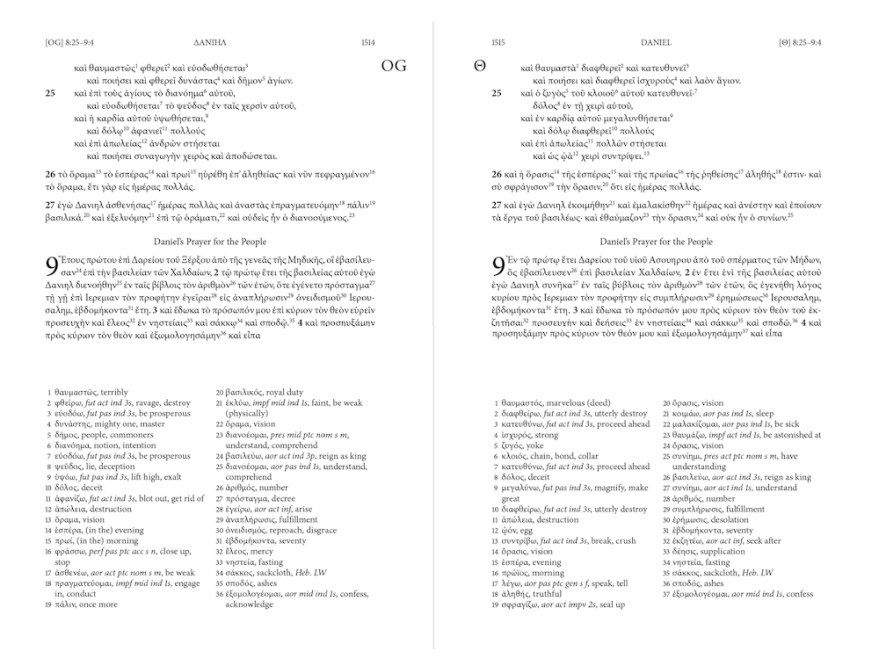
As is well known in the field of Septuagint studies, certain books developed over time into distinct textual forms. That is, in some cases there are what look like two different Greek versions of the same book in the Septuagint corpus. In such cases, the manuscript evidence preserves two textual traditions that are substantially different enough that Rahlfs decided to differentiate them in his edition of the Septuagint.* Since we decided to use Rahlfs-Hanhart as a base text, when it came to producing the Reader’s Edition we had to ask ourselves how we would handle these “double texts,” as they are often called.
Critical Editions
Within Rahlfs-Hanhart, these double texts include the following books (or portions):
- Judges: Alexandrinus text-type vs. Vaticanus text-type
- Daniel corpus (Daniel, Additions to Daniel, Susanna, Bel and the Dragon): Old Greek vs. Theodotion
- Tobit: GI (found in Vaticanus, Alexandrinus, and numerous others) and GII (primarily found in Sinaiticus)
- Portions of Joshua (e.g., 18:21b-19:45): Alexandrinus vs. Vaticanus
For these books Rahlfs-Hanhart prints one textual tradition at the top of a given page, followed by a dividing line, followed by the other textual tradition at the bottom. Each has its own text-critical apparatus. Göttingen Tobit does the same. This solution works well enough in those editions.
How We Handled Them
However, for our Reader’s Edition, we needed to take a different approach than that of Rahlfs. Stacking the double texts on one page, each with its own vocabulary apparatus, proved to be an unsightly mess and a sub-optimal reading experience as we conceptualized it.
As with everything in this project, it took a lot more thinking and beta-testing to get it right than we ever imagined!
We settled on printing the two textual forms (for the sections mentioned above) on facing pages, similar to Göttingen Daniel/Susanna/Bel. Where the texts allowed we aligned the corresponding passages as closely as possible; in general this was straightforward, though in spots where the textual traditions deviate quite a lot in content (even in their versification), we simply did the best we could to make it work visually.
Each of the facing pages, then, has its own vocabulary apparatus just like any other page. When the same word is used in each text, we did our best to match the glosses unless it did not make sense to do so. The same applies to the English sub-headers.
We also experimented with several options for visually differentiating the two text forms, so that the reader knows which textual tradition they’re reading on the left-hand side versus the right-hand side. Thanks to some hard work by the Hendrickson team, we arrived at marking such pages on the inside margins (the gutter) with a large letter corresponding to the textual tradition on that page. Anything more than that proved to be too distracting to the reader.
We also, consequently, had to deal with situations where we needed to start a new book on an even page (right-hand side) but were in a double text scenario and could not do so (since, if you’re tracking with us, such a scenario would break the left-right approach). In those cases, we inserted a divider page explaining that the next (odd-numbered) page begins the new book with double texts on facing pages.
Take a look at this sample of the final product, taken from Daniel (click to enlarge):
_______________________
* In some cases, the double texts are (or will be) handled differently in the ongoing Göttingen critical edition of the Septuagint. For example, the current editor of LXX-Judges has enough additional evidence at his disposal that he is reconstructing a single Old Greek text.
Note: Header image shows the end of Esther and beginning of Tobit in Codex Sinaiticus (www.codexsinaiticus.org)


Reblogged this on Words on the Word.
LikeLike
Reblogged this on Talmidimblogging.
LikeLike
Reblogged this on Hendrickson Publishers Blog.
LikeLike
Reblogged this on Greg Lanier and commented:
In this post, we elaborate on how we handled the few books of the Greek OT (and apocrypha) that apparently circulated in two somewhat distinct textual forms.
LikeLike
Reblogged this on Septuaginta &c. and commented:
More information about our forthcoming Reader’s Edition of the Septuagint.
LikeLike
Reblogged this on Zwinglius Redivivus and commented:
More from Will.
LikeLike
I’m putting this on the LXX reading group on Facebook and my Greek blog. Thanks.
LikeLike
It looks great too
LikeLike
V. nicely done (and great choice of fonts).
LikeLiked by 1 person
Sharing on https://www.facebook.com/TheSeptuagint/.
LikeLike